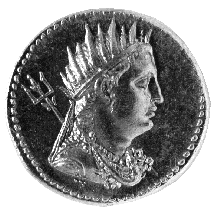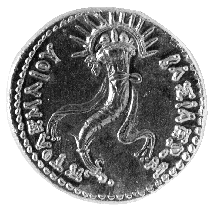



(58) Egypt, Ptolemy IV Philopator - AV octodrachm, c. 221-205
B.C., 27.82 g. (inv. 91.100).
Obverse: Bust of Ptolemy III r., wearing radiate diadem and aegis, scepter-trident
behind shoulder.
Reverse: Radiate cornucopia bound with fillet; ![]()
![]() : of King Ptolemy.
: of King Ptolemy.
Provenance: Numismatic Fine Arts, 1989.
Bibliography: J. Svoronos, Ta Nomismata tou Kratous ton Ptolemaion
2 (Athens 1904) 1131, pl. 36.4; O. Mørkholm, Early Hellenistic
Coinage from the Accession of Alexander to the Peace of Apamea (336-188
B.C.) (Cambridge 1991) 108-109.
This coin depicting Ptolemy III Euergetes (Benefactor) was issued by his
successor, Ptolemy IV Philopator (Father-lover), as a gesture of dynastic
continuity and of the filial piety that his name implies. Ptolemy III was
the son of Ptolemy II and Arsinoe II. He married his cousin Berenike II,
princess of Kyrene, thereby reuniting Egypt with Kyrene, which Ptolemy II
had lost. He carried on a successful war against Syria and acquired important
cities in Asia Minor and Thrace.
The portrait on the obverse confers upon Ptolemy III several attributes
of divinity. He wears the aegis associated with Zeus that had been an attribute
of Ptolemy I Soter (see no. 54). The trident that forms part of his scepter
alludes to Poseidon, god of the sea, and to Ptolemaic naval power, which
was at its height under Ptolemy III. The radiate diadem on the portrait
head and the rays over the cornucopia on the reverse refer to the sun god,
Helios. The cornucopia itself refers to the abundance and prosperity of
Egypt.
K.J.B.



All contents copyright (c) 1996.
Lawrence University
All rights reserved.